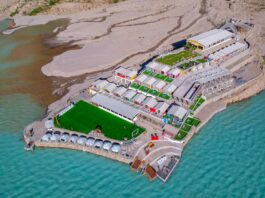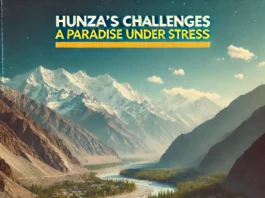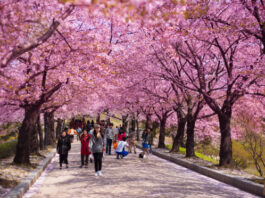Have you read about the interesting traditions of glacier marriage in Gilgit-Baltistan? Here glaciers are male and female, they have special features and appearance and after their marriage, new glaciers are born!
Interestingly, science also validates the entire process of how glaciers grow.
Haider and his villagers claim that the glacier fruit growing above the valley was planted by their ancestors about 150 years ago. Manawar village is located near Skardu at an altitude of 2,228 above sea level. Manawar is a big village with about 500 families. All of them are employed in agriculture. Haider is a 50-year-old middle-aged man, his family consists of ten members. He grows wheat, potatoes and vegetables on his land. He is considered one of the luckiest people in the village and credits his good fortune to the elders who solved the water shortage problem by grafting a glacier over the valley. Now the land of his village was inhabited.
Although the Gilgit-Baltistan area is considered the headland of glaciers and there are more than 7,000 small and big glaciers, but still there are many areas that are located above the river where water does not reach and there are no glaciers naturally. Glaciers have been artificially planted in areas for centuries to solve the problem of water scarcity. This is also called glacier grafting. This procedure is done on the basis of centuries of tradition as well as technical grounds which are however recognized by science.
Apart from this, water resources are also affected as a result of climate change, so the trend of glacier grafting has been increasing since last one decade.
The most important thing for installing a glacier is choosing a place that is at least four to five thousand meters above sea level and where the temperature remains negative throughout the year. Snowfall and avalanches are common there and direct sunlight does not reach. This place can be a cave in a rock or a deep pit is lost.
Woman and man glacier
There are also some interesting traditions associated with this process, for example, according to local traditions, some glaciers are male and some are female, in which male glaciers are dark in color and contain a lot of mud and stones along with snow. While the female glacier is bright milky or bluish in color. Stories of female and male glaciers are common in Gilgit-Baltistan. Similar traditions are also seen in other countries, for example at the Punakha Dzong, a sacred Buddhist site in Bhutan, where the two rivers meet, the calm flowing river is called the Mochu (Woman River) and the raging river. It is called Pochu (Male River).
Liaqat Ali Balti, a young resident of Skardu who makes documentaries by profession. He says, “People of Gilgit-Baltistan consider glaciers as living bodies, that’s why they liken them to women and men glaciers.” According to them, new glaciers are created by the fusion of male and female glaciers. Male glaciers are called “Po gang” and female glaciers are called “Mo gang”. According to them, male glaciers receive less water and are slow moving, while female glaciers are growing glaciers that receive a lot of water.”
For grafting, two different pieces (about 35 kg) are taken from these male and female glaciers and placed in this specific place. According to the local tradition, people wrap these pieces of ice in a wicker basket and carry them on their shoulders without stopping. They don’t stop on the way, don’t talk, and don’t put these pieces of ice on the ground. Placed in a pre-selected specific place, the pieces are covered with mud, ash and charcoal etc. and the pit or cave is closed with large stones. Collective prayers and animals are also slaughtered on this occasion for blessings and success. Locally this process is also known as wedding of glaciers.
According to experts, after at least 10-12 years, these pieces of ice become mature glaciers and start receiving water from them. Everyone in Gilgit-Baltistan can talk about glacier grafting, everyone has a story, mostly hearsay that is passed down from generation to generation, but there are very few people who have been involved in the process themselves. Have participated.
Shamsher Ali of Kharmang Wah is also one of them who participated in this process on behalf of Aga Khan Rural Support Program.
He says that it was twelve years ago, I was also a part of the glacier grafting team of AKRSP who were doing glacier grafting in Kharming. Our team consisted of young people. Young people are needed in this work because pieces of glaciers have to be lifted from several kilometers away and carried to very high altitudes to be grafted. We brought pieces of glaciers from Arundu village near Shagar and we continued carrying these pieces for two continuous days and nights. If one was tired, the other would pick him up and put him on his shoulder. Thus it took two days to arrive.”
Shamsher further said that “I went there 5 years ago and saw that the glacier had grown and spread out of the cave.” He says that before this glacier there was a shortage of water in our village, but now there is water in our rivers and canals. The amount has increased by fifty percent and now wheat, barley, millet and vegetables are being cultivated regularly in our village. Earlier, water was not available regularly, so the crops usually failed.
Nazir Ahmad, who is associated with the Aga Khan Rural Support Program as a manager, says that his organization has so far transplanted glaciers at nineteen different locations and we have achieved 80% success.
Although the Aga Khan program does not only cover folk traditions, an example of this can be seen in the cross-border region of Ladakh, where a retired engineer, Chhewang Norphel, diverted a mountain river in 1987 to slow its flow so that the water would flow slowly. Later, another engineer, Sonam Wangchuk, advanced this technique to create ice stupas.
History of Glacier Transplantation
According to Ishtiaq Ali of the University of Baltistan, the earliest traditions date back to the period when Amir Kabir Syed Ali Hamdani (1314-1384 AD), a famous preacher and religious leader in the region, came here and people complained to him that the people of Tibet and Kashgar We should be protected from the attackers. The first glaciers were formed during this period to close the mountain passes through which invaders came into these regions. Further evidence comes from the colonial period,
According to Inayatullah Faizi, Assistant Professor, Government Degree College, Chitral, though it is difficult to say when the first glacier was planted in the area, there is evidence that a glacier was planted in 1812 for irrigation. Further documentary evidence comes from DLR Lorimer, a British administrator in the 1920s, who, although declaring the technique of glacier grafting obsolete, was grateful that these same glaciers had provided a continuous food supply to the British Raj. –
Glaciers and women
Although glacier grafting is considered a purely male activity, it also directly benefits women. Grafting glaciers increases water supply for agriculture and domestic use and makes women’s lives a little easier.
Tehsib Bano from Gilgit is doing MPhil in Climate Change and Development from National University of Science and Technology Islamabad. His thesis topic
“Glacier Grafting: A Community Based Adaptation to the Climate Induced Food Insecurity in the Himalayan Ranges of Pakistan”
The culture says that although women do not directly participate in this activity, having water close to home makes their lives easier. For his thesis, Tehsaf had done research on the artificial glaciers of Gol, Khurmang and Machlu (Ghanche) and he says that the amount of water in these areas has increased by 50% and successfully cultivated wheat, Maize, millet and vegetables are being cultivated.
Rashiduddin, the field officer of the project associated with GLOPH 2 (GLOG2), which is a joint project of the Ministry of Climate Change and UNDP, which is financed by the Green Climate Fund, said that we have carried out glacier grafting activity in the upper area of Kawardo village. has done and tried to keep women together through counseling and practice. Rashiduddin said that water has become precious for them and sex has become rare. Although the river Indus passes at some distance from Kawardo village, it is not easy to walk on this sandy path carrying heavy loads. During this glacier grafting, it started snowing which was considered a “good omen”. Also, there has been a lot of snow this year and the temperature at the altitude where the glacier is grafted will surely be minus forty. We hope this process will be successful with so much snow.
It is hoped that the water that will be obtained from this glacier will be able to cultivate more than two thousand kanals of land. 4 more glaciers will be grafted this year, which is expected to fertilize eight to ten thousand kanals of land in the future.
Folk traditions and science
Baltistan University Director of Academic and Linkages Dr. Zakir Hussain says that the science in this regard is still in its evolutionary stages, but we can say that “when pieces of the ice surface are preserved for a long time in a place where certain temperature If humidity, humidity, rains and snow continue to fall, after a certain time when the process of melting and growth becomes uniform, these pieces of ice start growing and thus new glaciers come into existence.
Another climate change expert, Dr. Asif Khan, who today
IPCC, WG-I, AR-6 Water Chapter
He is the main author of, he says that due to the increase in temperature, the snow is melting faster in the Hindu Kush Himalayas, which has accelerated the melting of glaciers. In such a case, artificially increasing the glaciers in the Hindu Kush and Himalayan region can be considered as an effective solution because here Glaciers are melting faster than Karakoram.
Article By: The Hunza Times Editor



